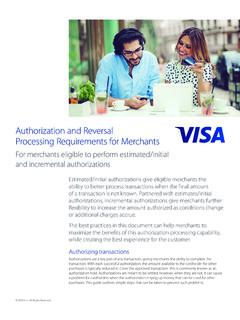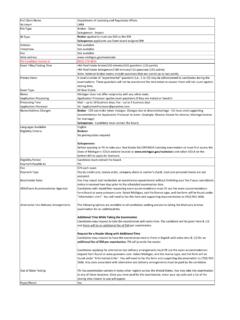Transcription of ANALYSIS The Impact of Electronic Payments on Economic …
1 The Impact of Electronic Payments on Economic GrowthIntroduction Greater worldwide card use raises a number of questions. Foremost, do Electronic Payments bring macroeconomic benefits? Moody s Analytics attempted to answer this question by analyzing macroeconomic data for 70 countries/regions between 2011 and 2015. By calculating the Impact of card usage on per capita consumption, Moody s Analytics was able to extrapolate the effect that the increase in spending on goods and services had on consumption and thereby GDP. Specifically, Moody s Analytics estimated that higher card usage contributed an additional $296 billion to consumption between 2011 and 2015, or a cumulative increase in global GDP during the sample time period.
2 That equals about a $74 billion contribution to GDP each year. real consumption grew at an average of in the same period, of which percentage point is attributable to increased card penetration. This implies that card usage accounted for about of growth in consumption, as well as an average increase of million jobs over 2011-2015. ANALYSISP repared byMark EconomistSophia DirectorVirendra UsEmail + (London) + (Prague)Asia/Pacific + Others + S ANALYTICS2 FEBRUARY 2016 Table of ContentsExecutive Summary ..1 Part I: Introduction: The Macroeconomic Impact of Electronic Payment Usage ..3 Part II: The Value of Electronic Payments : Less Friction, More Efficiency.
3 4 Part III: Model Estimation ..6 Part IV: Contribution of Card Usage on Consumption and GDP ..7 Part V: Contribution of Card Usage on Employment ..10 Part VI: Ongoing Effects on GDP of Greater Card Penetration: Measuring Elasticity by Country ..12 Part VII: The Evolution of the Report s Methodology ..14 Part VIII: Conclusion ..15 Appendix ..16 MOODY S ANALYTICS1 FEBRUARY 2016 Executive SummaryRising Card Payments Drive Economic Growth Payment cards are not just convenient but also play a crucial role in stimulat-ing Economic growth in countries around the the last 50 years, the rapid prolifera-tion of Electronic Payments in particular credit, debit and prepaid cards has changed how consumers pay for goods and services, how merchants manage their businesses, and how governments make and collect all sorts of Payments .
4 Electronic Payments pro-vide consumers with convenient and secure access to their funds, reduce cash and check handling for merchants, and expand the pool of customers who are guaranteed to pay. Im-portantly, they also promote greater finan-cial inclusion, giving those without access to the formal banking system an introduc-tion to formal financial services. Electronic Payments also give governments a greater ability to collect additional tax revenue by reducing the number of unreported transac-tions in the gray economy. All of this reduces friction in the overall economy and leads to increased spending on goods and services. That, in turn, creates a virtuous Economic cycle whereby increased consumption translates into increased production, more jobs, higher incomes and greater Economic prosperity.
5 But just how much has the expansion of Electronic Payments contributed to global Economic growth in recent years? What has been the Impact on GDP and employment, and has this Impact differed between devel-oped countries and emerging markets? Moody s Analytics set out to answer these questions by examining the Impact that the migration toward Electronic Payments has had on 70 countries/regions around the globe over a five-year period between 2011 and 2015. Together, these economies make up almost 95% of world gross domestic product. Over-all, Moody s Analytics found that: Electronic Payments added $296 billion in real ( ) dollars to GDP in the 70 countries/regions studied between 2011 and 2015.
6 That is equivalent to the creation of about million jobs on average per year over the five-year period, or about of total em-ployment in the 70 countries/regions. Countries/regions with the largest increases in card usage experienced the biggest contributions to growth. For example big increases in GDP were recorded in Hungary ( ), the United Arab Emirates ( ), Chile ( ), Ireland ( ), Poland( ) and Australia ( ). In most countries/regions, card usage increased regardless of Economic performance. Only in the case of Finland, Greece and Tunisia did card usage decline when Economic performance deterio-rated or other macro events affected activity.
7 As a result, consumption was weaker than it would have been had card penetration increased or remained unchanged. Increased Electronic Payments resulted in roughly the same per-centage increase in GDP between 2011 and 2015 for emerging markets ( ) as for developed countries ( ). However, when card usage increases by 1% across countries/regions, developed countries/regions experience a larger percentage increase in GDP ( ) than do emerging markets ( ). This suggests there is a compounding benefit for advanced countries/regions as Electronic Payments usage deepens. The expansion of Electronic pay-ments could have a significant, positive effect on future Economic growth.
8 Across the 70 countries/regions in the study, we found that each 1% increase in usage of Electronic Payments pro-duces, on average, an annual increase of approximately $104 billion in the consumption of goods and services, or a increase in GDP, assuming all other factors remain the same. Electronic Payments could also have a significant improvement on spending habits. Given recent card penetration rates, growth rates and the additive effects, Moody s Analytics calculated that consumption was higher between 2011 and 2015 than it would have been if Electronic Payments had not increased; total consumption increased on average by over the sample period.
9 Because consumption growth is on average faster in emerging economies, emerging economies have more to gain by increasing Electronic Payments usage to speed consump-tion gro wth even further. Consumption growth in both emerging economies and developed countries/regions benefits from additional card study marks the third time that Moody s Analytics has conducted this ANALYSIS and the results suggest again that both emerging economies and developed countries/regions benefit from increasing Electronic Payments . However, penetration in and of itself will not necessarily spur growth. Successful penetration goes hand in hand with a well-developed financial system and a healthy economy.
10 This study found that developed countries/regions had a larger dollar increase in GDP MOODY S ANALYTICS2 FEBRUARY 2016 than did emerging markets. On a cautionary note, slippage in Electronic Payments usage, such as that seen in Finland and Greece, is estimated to have reduced the resilience of consumer spending in these countries/regions to the downturn in their this study provides a comprehen-sive look at the Impact of Electronic pay-ments on Economic growth between 2011 and 2015, it does not consider as exogenous variables in our model a country s fiscal poli-cies nor the strength of a country s financial system such as the stability of the banking sector or prevalence of financial infrastruc-ture such as ATMs.














